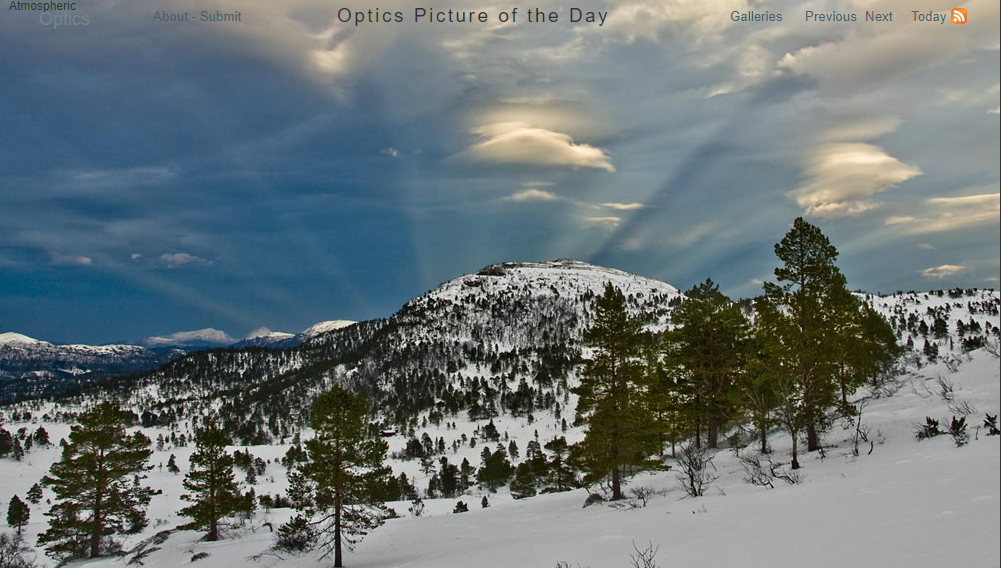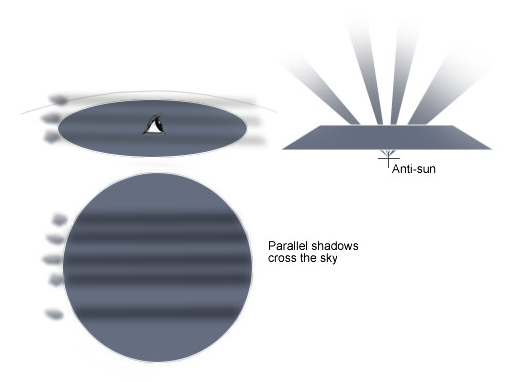Rays to the anti-sun
Rays to the Anti-Sun: A Phenomenon of Atmospheric Optics
Have you ever witnessed a captivating display of shadows and rays seemingly converging towards a point directly opposite the sun? This intriguing phenomenon, known as "rays to the anti-sun," or more precisely, "anti-crepuscular rays," has fascinated sky observers for centuries. In this blog post, we will delve into the intricacies of this optical spectacle, exploring its causes, characteristics, and the science behind its formation.
The Antisolar Point and Shadow Convergence
When we observe anti-crepuscular rays, we notice that the long shadows cast by objects on the ground appear parallel but converge towards a focal point opposite the sun. These shadows and rays create a mesmerizing visual effect that seems to oppose the twilight hour, earning them their peculiar name. However, it is more accurate to refer to them as "anti-solar rays" to describe their true nature.
The reason these shadows and rays appear to converge is due to a phenomenon known as perspective. From our vantage point on Earth's surface, our eyes perceive the convergence of parallel lines towards the antisolar point. This point is precisely opposite the position of the sun in the sky.
Darkening Shadows and Atmospheric Corridors
As anti-crepuscular rays approach the antisolar point, they gradually darken. This darkening occurs because our eyes are no longer looking across the shadowed air corridors but instead peering along their length. Consequently, we perceive a greater depth of shadowed air, leading to a darker appearance.
The interplay between light and shadow in this phenomenon can be truly captivating. The contrast between the bright rays and the darkening shadows creates a stunning visual spectacle that draws our gaze towards the antisolar point, where the convergence of these elements occurs.
Exploring Storfjellet: A Captivating Example
One particularly remarkable occurrence of anti-solar rays was captured by Lars Brub�k over Storfjellet, "The Big Mountain," in Angvika, Norway. As Lars describes, finding a specific "Storfjell" in Norway can be akin to searching for a single straw in a haystack, as many small villages have their own versions. In this instance, Storfjellet served as the backdrop for the awe-inspiring display of anti-crepuscular rays.
The Grammar of Storfjell and Storfjellet
To clarify the linguistic nuances, it is worth noting that "Storfjell" translates to "Big mountain" in Scandinavian grammar. However, "Storfjellet" specifically refers to "The big mountain." This distinction highlights the importance of context and specificity in the Norwegian language.
Understanding the Science Behind Anti-Solar Rays
To truly appreciate the beauty of anti-solar rays, it helps to understand the science behind their formation. These rays are a result of the interaction between sunlight and atmospheric particles such as dust, water droplets, and ice crystals. As sunlight passes through the atmosphere, it scatters off these particles, creating the visible rays that we observe.
The convergence of anti-solar rays towards the antisolar point occurs due to the perspective effect mentioned earlier. This convergence is an optical illusion caused by our viewing position on Earth. The rays themselves are parallel but appear to meet at a focal point opposite the sun, providing us with a breathtaking spectacle that seems to defy conventional perception.
Additional Factors Influencing Anti-Crepuscular Rays
While perspective plays a significant role in the formation of anti-solar rays, other factors can also influence their appearance. These factors include:
- Cloud formations: Broken or projecting clouds can contribute to the formation and shape of anti-crepuscular rays, adding complexity and variety to their visual display.
- Topography: The presence of mountains or other elevated features can cast shadows and interact with the rays, further enhancing their beauty and complexity.
- Atmospheric conditions: Variations in atmospheric humidity, temperature, and the presence of different aerosols can affect the scattering of sunlight and contribute to the overall appearance of anti-solar rays.
The Allure of Atmospheric Optics
Anti-solar rays are just one example of the captivating phenomena that can occur within the realm of atmospheric optics. From rainbows and halos to mirages and iridescence, the interplay between light and the atmosphere never fails to astound us. Exploring these natural wonders not only deepens our understanding of the world around us but also offers a glimpse into the awe-inspiring beauty and complexity of nature.
So, next time you find yourself gazing at the sky during twilight hours, keep an eye out for the mesmerizing display of anti-solar rays. These converging shadows and rays serve as a reminder of the remarkable phenomena that occur in our atmosphere, constantly reminding us of the wonders that surround us.

Anti-Sun rays over Storfjellet. ("The Big Mountain"), Angvika, Norway
Imaged by Lars Brub�k. "The setting sun was behind me, to the South South West . The shadows were possibly caused by broken or projecting cloud, or the up to 1800 m high peaks between me and the coast.." �Lars Brub�k, shown with permission.
.Lars comments further: "Looking for a 'Storfjell' (Big Mountain) in Norway is more or less like trying to find one specific straw in a haystack. Many small villages have their own. And they need not be very large, only to look the largest of those close by. Then some clarification regarding Scandinavian grammar, Storfjell = Big mountain. Storfjellet = The big mountain." This particular Storfjell is located on Google Earth here.

Shadows and rays plunge down toward a focus at the anti-sun. They are named 'anti-crepuscular' as though opposing the 'crepusculum' - twilight. 'Anti-solar' portrays their guise with more precision.
The long shadows are parallel and only appear by perspective to converge towards the point directly opposite the sun.
They darken as they near the antisolar point because the eye looks increasingly along the long corridors of shadowed air rather than across them.
Note: this article has been automatically converted from the old site and may not appear as intended. You can find the original article here.
Reference Atmospheric Optics
If you use any of the definitions, information, or data presented on Atmospheric Optics, please copy the link or reference below to properly credit us as the reference source. Thank you!
-
<a href="https://atoptics.co.uk/blog/rays-to-the-anti-sun/">Rays to the anti-sun</a>
-
"Rays to the anti-sun". Atmospheric Optics. Accessed on April 19, 2024. https://atoptics.co.uk/blog/rays-to-the-anti-sun/.
-
"Rays to the anti-sun". Atmospheric Optics, https://atoptics.co.uk/blog/rays-to-the-anti-sun/. Accessed 19 April, 2024
-
Rays to the anti-sun. Atmospheric Optics. Retrieved from https://atoptics.co.uk/blog/rays-to-the-anti-sun/.